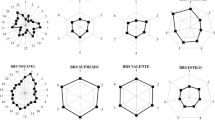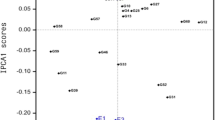Abstract
Common bacterial blight (CBB) of mungbean (Vigna radiata [L.] Wilczek var. radiata) is a major limitation to mungbean production in semi-arid areas of the world where mungbean is a major crop. Deployment of resistant varieties is a significant sustainable strategy for controlling CBB in marginal production systems. The objective of this study was to identify sources of resistance and the stability of mungbean landraces to CBB attack across drought-endemic environments. A total of 240 mungbean genotypes were evaluated for CBB resistance and performance of agronomic traits in an alpha lattice design at four locations for 2 years (2019, 2020). Data were subjected to residual maximum likelihood (REML) analysis to partition variance components attributed to main effects and interactions, respectively. REML analysis revealed significant main effects for genotype, environment (combination of cropping season and location) and genotype-by-environment interaction (p < 0.01), demonstrating the influence of environment on genotypic expression. A genotype main effect plus genotype-by-environment biplot was used to analyse the multi-location trial data based on CBB score to determine genotypic stability. The GGE analysis demonstrated that the Kambi Ya Mawe location in 2019 was the most suitable environment for the assessment of CBB resistance. Accessions GBK 004852, GBK 004789, GBK 026986, GBK 004970, GBK 004961, GBK 004882 and GBK 043573 were selected as having high and stable resistance across all environments. The identification of high and stable resistance sources is a first step towards deploying resistance in mungbean breeding programmes against CBB and the future deployment of resistant cultivars.


Similar content being viewed by others
Availability of data and materials
All the datasets supporting the conclusions of this article are included within the article and its supporting information files provided as accompanying supplementary materials.
References
Aggour AR, Coyne DP, Vidaver AK (1989) Comparison of leaf and pod disease reactions of beans (Phasepolus vulgaris L.) inoculated by different methods with strains of Xanthomonas campestris pv. Phaseoli (Smith) dye. Euphytica 43:143–152. https://doi.org/10.1007/BF00037907
Akcura M, Akan K, Hocaoglu O (2017) Biplot analysis of leaf rust resistance in pure lines selected from eastern Anatolian bread wheat landraces of Turkey. Turk J Field Crops 22:227–234. https://doi.org/10.17557/tifc.356231
Alam AKMM, Somta P, Jompuk C, Chatwachirawong P, Srinives P (2014) Evaluation of mungbean genotypes based on yield stability and reaction to mungbean yellow mosaic virus desease. Plant Pathol J 30:1–8. https://doi.org/10.5423/PPJ.OA.03.2014.0023
Asian Vegetable Research and Development Centre (AVRDC) (2019) International Mungbean Improvement Network–World Vegetable Center. https://avrdc.org/intl-mungbean-network. Accessed June 2020
Ceccarelli S, Grando S (2007) Decentralized-participatory plant breeding: an example of demand driven research. Euphytica 155:49–360
Chatterton S, Balasubramanian PM, Erickson RS, Hou A, Mclaren DL, Henriquez MA, Conner RL (2016) Identification of bacterial pathogens and races of Pseudomonas syrinagae pv. phaseolicola from dry bean fields in Western Canada. Can J Plant Pathol 38:41–54. https://doi.org/10.1080/07060661.2016.1141800
Chaudhari S, Khare D, Patil SC, Sundravadana S, Variath MT, Sudini HK, Manohar SS, Bhat RS, Pasupuleti J (2019) Genotype × environment studies on resistance to late leaf spot and rust in genomic selection training population of peanut (Arachis hypogaea L.). Front Plant Sci 10:1338. https://doi.org/10.3389/fpls.2019.01338
Dahiya PK, Linnemann AR, Van Boekel MAJS, Khetarpaul N, Grewal RB, Nout MJR (2015) Mungbean: technological and nutritional potential. Crit Rev Food Sci Nutr 55:670–688
Ddamulira G, Mukankusi C, Ochwo-Ssemakula M, Edema R, Sseruwagi P, Gepts P (2014) Identification of new sources of resistance to angular leaf spot among Uganda common bean landraces. Can J Plant Breed 2:55–65
Duncan RW, Singh SP, Gilbertson RL (2011) Interaction of common bacterial blight bacteria with disease resistance quantitative trait loci in common bean. Phytopathology 101:425–435. https://doi.org/10.1094/PHYTO-03-10-0095
Ferreira DF, Demétrio CGB, Manly BFJ, de Almeida Machado A, Vencovsky R (2006) Statistical models in agriculture: biometrical methods for evaluating phenotypic stability in plant breeding. Cerne 12:373–388
Ferreira JJ, Campa A, Perez-Vega E, Rodriguez-Suarez C, Giraldez R (2012) Introgression and pyramiding into common bean market class fabada of genes conferring resistance to anthracnose and potyvirus. Theor Appl Genet 124:777–788. https://doi.org/10.1007/s00122-011-1746-x
Ganiyu SA, Popoola AR, Owolade OF, Fatona KA (2017) Control of common bacterial blight disease of cowpea (Vigna unguiculata [L.] Walp) with certain plant extracts in Abeokuta, Nigeria. J Crop Improv 31:280–288
Gauch HG (2006) Statistical analysis of yield trials by AMMI and GGE. Crop Sci 46:1488–1500
Gupta S, Pratap A (2016) Mungbean summer cultivation in India (pocket guide). All Indian Coordinated Research Project (AICRP) on MULLaRP. Indian Institute of Pulses Research, Kanpur. Extension Bulletin 208024
Hegstad JM, Nelson RL, Renny-Byfield S, Feng L, Chaky JM (2019) Introgression of novel genetic diversity to improve soybean yield. Theor Appl Genet 132:2541–2552
Jacques MA, Josi K, Darrasse A, Samson R (2005) Xanthomonas axonopodis pv. phaseoli var. fuscans is aggregated in stable biofilm population sizes in the phyllosphere of field-grown beans. Appl Environ Microbiol 71:2008–2015. https://doi.org/10.1128/AEM.71.4.2008-2015.2005
Jaetzold R, Hornetz B, Shisanya CA, Schmidt H (2012) Farm management handbook of Kenya, vol. 1–4 (Western, Central, Eastern, Nyanza, Southern Rift Valley, Northern Rift Valley and Coast). Government Printers, Nairobi. https://www.unitrier.de/index.php?id=58581
Kang YJ, Kim SK, Kim MY, Lestari P, Kim KH, Ha BK, Shim S (2014) Genome sequence of mungbean and insights into evolution within Vigna species. Nat Commun 5:5443–5447
Karimi R, Nair RM, Ledesma D, Mutisya DL, Muthoni L (2019) Performance and participatory evaluation of mungbean genotypes in the semi-arid environments of Eastern Kenya. East Afr Agric For J 83:119–136. https://doi.org/10.1080/00128325.2019.1599491
Kim SK, Nair RM, Lee J, Lee SH (2015) Genomic resources in mungbean for future breeding programs. Front Plant Sci 6:626
Leta A, Lemessa F, Ayana G (2017) Evaluation of common bean cultivars for their resistance against Xanthomonas Axonopodis Pv. Phaseoli. Ethiop J Appl Sci Technol 8:60–72
Malosetti M, Ribaut JM, van Eeuwijk FA (2013) The statistical analysis of multi-environment data: modeling genotype-by-environment interaction and its genetic basis. Front Physiol 4:44. https://doi.org/10.3389/fphys.2013.00044
Miklas PN, Kelly JD, Beebe SE, Blair MW (2006) Common bean breeding for resistance against biotic and abiotic stresses: from classical to MAS breeding. Euphytica 147:105–131. https://doi.org/10.1007/s10681-006-4600-5
Ministry of Agriculture, Livestock and Fisheries (MoALF) (2015) Economic reviews 2015. Ministry of Agriculture, Livestock and Fisheries, Nairobi
Opiol F, Kimani PM, Musaana SM, Buruchara R (2002) Research on common bacterial blight and halo blight of common bean in East and Central Africa. Annu Rep Bean Improv Coop 45:160–161
Osdaghi E (2014) Occurrence of common blight bacterial blight on mungbean (Vigna radiata) in Iran caused by Xanthomonas axonopodis pv. Phaseoli. New Dis Rep 30:9. https://doi.org/10.5197/j.2044-0588.2014.030.009
Pande S, Sharma M, Gaur PM, Basandrai AK, Kaur L, Hooda KS, Rathore A (2013) Biplot analysis of genotype × environment interactions and identification of stable sources of resistance to Ascochyta blight in chickpea (Cicer arietinum L.). Australas Plant Pathol 42:561–571
Parihar AK, Basandrai AK, Sirari A, Dinakaran D, Singh D, Kannan K, Paranidharan V (2017) Assessment of mungbean genotypes for durable resistance to yellow mosaic disease: genotype × environment interactions. Plant Breed 136:94–100
Patterson HD, Thompson R (1971) Recovery of inter-block information when block sizes are unequal. Biometrika 58:545–554
Piechota U, Czembor PC, Slowacki P, Czembor JH (2019) Identifying a novel powdery mildew resistance gene in a barley landrace from Morocco. J Appl Genet 60:2243–2254
Pietrusinska A, Zurek M, Piechota U, Slowacki P, Smolinska K (2019) Searching for disease resistance sources in old cultivars, landraces and wild relatives of cereals: a review. Ann UMCS Agric 73:45–60. https://doi.org/10.2432/asx.2018.4.5
Pranamika S, Saikia MK (2013) Management of late blight of potato through chemicals. IOSR J Agric Vet Sci 2:23–36
Rubiales D, Flores F, Emeran AS, Kharrat M, Amri M, Rojas-Molina MM, Sillero JC (2014) Identification and multi-environment validation of resistance against broomrapes (Orobanche crenata and O. foetida) in faba bean (Vicia faba). Field Crops Res 166:58–65
Saettler AW (1989) Common bacterial blight. In: Schwartz HF, Pastor-Corrales MA (eds) Bean production problems in the tropics. CIAT, Cali, pp 261–283
Simko I, Piepho HP (2012) The area under the disease progress stairs: calculation, advantage, and application. Phytopathology 102:381–389
Singh SP, Miklas PN (2015) Breeding common bean for resistance to common blight: a review. Crop Sci 55:971–984
Singh SP, Muñoz CG (1999) Resistance to common bacterial blight among Phaseolus species and common bean improvement. Crop Sci 39:80–89. https://doi.org/10.2135/cropsci1999.0011183X003900010013x
Singh SP, Schwartz HF (2010) Breeding common bean for resistance to diseases: a review. Crop Sci 50:2199–2223. https://doi.org/10.2135/cropsci2009.03.0163
Singh B, Das A, Parihar AK, Bhagawati B, Singh D, Pathak KN, Kumar R (2020) Delineation of genotype-by-environment interactions for identification and validation of resistant genotypes in mungbean to root-knot nematode (Meloidogyne incognita) using GGE biplot. Sci Rep 10:1–14
Tar’an B, Michaels TE, Pauls KP (2001) Mapping genetic factors affecting the reaction to Xanthomonas axonopodis pv. phaseoli in Phaseolus vulgaris L. under field conditions. Genome 44:1046–1056. https://doi.org/10.1139/gen-44-6-104
Urrea CA, Miklas PN, Beaver JS (1999) Inheritance of resistance to common bacterial blight in four tepary bean lines. J Am Soc Hortic Sci 124:24–27
Yan W, Hunt LA, Sheng Q, Szlavnics Z (2000) Cultivar evaluation and mega-environment investigation based on the GGE biplot. Crop Sci 40:597–605
Yan W, Kang MS, Ma B, Woods S, Cornelius PL (2007) GGE biplot vs. AMMI analysis of genotype-by-environment data. Crop Sci 47:643–653
Yang RC, Crossa J, Cornelius PL, Burgueño J (2009) Biplot analysis of genotype × environment interaction: proceed with caution. Crop Sci 49:1564–1576
Yu ZH, Stall RE, Vallejos CE (1998) Detection of genes for resistance to common bacterial blight of beans. Crop Sci 38:1290–1296. https://doi.org/10.2135/cropsci1998.0011183X003800050028x
Acknowledgements
We are grateful to the Centre of Excellence in Sustainable Agriculture and Agribusiness Management (CESAAM) project, Egerton University for providing funds for the study. Funding support was also provided by the Agricultural Finance Kenya Climate Smart Agricultural Productivity Project (AgriFi Kenya CS APP), Kenya Agricultural and Livestock Research Organization (KALRO). We acknowledge Egerton University’s institutional support. KALRO Katumani and Perkerra research centres provided fields for the experiments. We gratefully acknowledge KALRO Genetic Resources Research Institute (GeRRI) for providing the germplasm.
Funding
Funds for the study were provided by Centre of Excellence in Sustainable Agriculture and Agribusiness Management (CESAAM) project, Egerton University. This is a World Bank funding support for the training Master of Science and Doctor of Philosophy students in Agriculture in sub-Saharan Africa. Extra funding support was provided by Agricultural Finance Kenya Climate Smart Agricultural Productivity Project (AgriFi Kenya CS APP) at the Kenya Agricultural and Livestock Research Organization (KALRO). The project is funded by the European Union and the Government of Kenya, as a food security initiative towards enhanced production of resilient crops for semi-arid regions of Kenya.
Author information
Authors and Affiliations
Contributions
JAT, PPOO, RK and JJM designed the experiment. JAT and PPOO analysed the data. JAT, PPOO, RK, HSN grew the plants and performed the phenotyping for agronomic and disease resistance. JAT wrote the draft manuscript, PPOO revised the draft manuscript. All authors made contributions towards compilation of the draft and proofreading and approved the final manuscript.
Corresponding author
Ethics declarations
Conflict of interest
The authors declare that they have no conflict of interest.
Additional information
Publisher's Note
Springer Nature remains neutral with regard to jurisdictional claims in published maps and institutional affiliations.
Electronic supplementary material
Below is the link to the electronic supplementary material.
Rights and permissions
About this article
Cite this article
Tollo, J.A., Ojwang, P.P.O., Karimi, R. et al. Genotype-by-environment interaction and stability of resistance in mungbean landraces against common bacterial blight across semi-arid environments. Euphytica 216, 175 (2020). https://doi.org/10.1007/s10681-020-02705-8
Received:
Accepted:
Published:
DOI: https://doi.org/10.1007/s10681-020-02705-8




